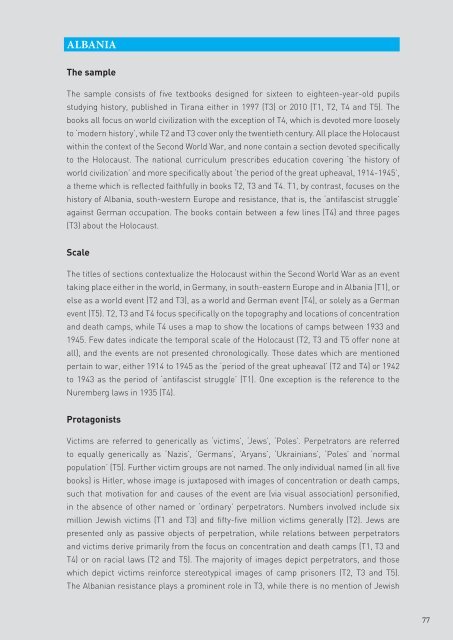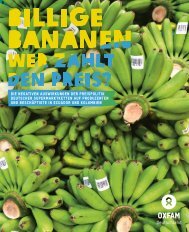228776e
228776e
228776e
You also want an ePaper? Increase the reach of your titles
YUMPU automatically turns print PDFs into web optimized ePapers that Google loves.
ALBANIA<br />
The sample<br />
The sample consists of five textbooks designed for sixteen to eighteen-year-old pupils<br />
studying history, published in Tirana either in 1997 (T3) or 2010 (T1, T2, T4 and T5). The<br />
books all focus on world civilization with the exception of T4, which is devoted more loosely<br />
to ‘modern history’, while T2 and T3 cover only the twentieth century. All place the Holocaust<br />
within the context of the Second World War, and none contain a section devoted specifically<br />
to the Holocaust. The national curriculum prescribes education covering ‘the history of<br />
world civilization’ and more specifically about ‘the period of the great upheaval, 1914-1945’,<br />
a theme which is reflected faithfully in books T2, T3 and T4. T1, by contrast, focuses on the<br />
history of Albania, south-western Europe and resistance, that is, the ‘antifascist struggle’<br />
against German occupation. The books contain between a few lines (T4) and three pages<br />
(T3) about the Holocaust.<br />
Scale<br />
The titles of sections contextualize the Holocaust within the Second World War as an event<br />
taking place either in the world, in Germany, in south-eastern Europe and in Albania (T1), or<br />
else as a world event (T2 and T3), as a world and German event (T4), or solely as a German<br />
event (T5). T2, T3 and T4 focus specifically on the topography and locations of concentration<br />
and death camps, while T4 uses a map to show the locations of camps between 1933 and<br />
1945. Few dates indicate the temporal scale of the Holocaust (T2, T3 and T5 offer none at<br />
all), and the events are not presented chronologically. Those dates which are mentioned<br />
pertain to war, either 1914 to 1945 as the ‘period of the great upheaval’ (T2 and T4) or 1942<br />
to 1943 as the period of ‘antifascist struggle’ (T1). One exception is the reference to the<br />
Nuremberg laws in 1935 (T4).<br />
Protagonists<br />
Victims are referred to generically as ‘victims’, ‘Jews’, ‘Poles’. Perpetrators are referred<br />
to equally generically as ‘Nazis’, ‘Germans’, ‘Aryans’, ‘Ukrainians’, ‘Poles’ and ‘normal<br />
population’ (T5). Further victim groups are not named. The only individual named (in all five<br />
books) is Hitler, whose image is juxtaposed with images of concentration or death camps,<br />
such that motivation for and causes of the event are (via visual association) personified,<br />
in the absence of other named or ‘ordinary’ perpetrators. Numbers involved include six<br />
million Jewish victims (T1 and T3) and fifty-five million victims generally (T2). Jews are<br />
presented only as passive objects of perpetration, while relations between perpetrators<br />
and victims derive primarily from the focus on concentration and death camps (T1, T3 and<br />
T4) or on racial laws (T2 and T5). The majority of images depict perpetrators, and those<br />
which depict victims reinforce stereotypical images of camp prisoners (T2, T3 and T5).<br />
The Albanian resistance plays a prominent role in T3, while there is no mention of Jewish<br />
77




